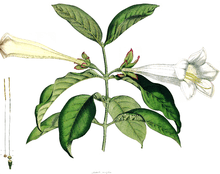Portlandia grandiflora
| Portlandia grandiflora | |
|---|---|
 | |
| J.E. Smith, M.D. Fasc. 1-3. | |
| Conservation status | |
| Scientific classification | |
| Kingdom: | Plantae |
| (unranked): | Angiosperms |
| (unranked): | Eudicots |
| (unranked): | Asterids |
| Order: | Gentianales |
| Family: | Rubiaceae |
| Genus: | Portlandia |
| Species: | P. grandiflora |
| Binomial name | |
| Portlandia grandiflora L. | |
Portlandia grandiflora is a species of plant in the Rubiaceae family. Commonly known as the Bell Flower, this plant is considered native to Jamaica but is also native to Cuba (VanZile 2014). It is mainly found in limestone montane forests although some occur on karst areas near Jamaica’s coast. It mostly grows on alkaline soils as can be observed by the habitats they are found in. In Jamaica, they flower most frequently in May, June, and August, and fruit during the months of January and December.
Key Features
The habit of this plant can be a small tree or a shrub up to 15 feet tall, and the flowers are hermaphroditic. These white trumpet shaped flowers can grow to about 6 inches long, and are followed by woody oval-shaped fruit 2-3cm long with a dry appearance (Tucker 2010). The large leaves are dark green with a pinnate venation, and have an opposite arrangement on the plant stem.
Ecology
The flower gives off a strong vanilla scent at night that attracts moths. These moths are known to be the pollinators of this Portlandia species (Burghart 2014). Seed dispersal is less obvious: they are evidently not wind dispersed and the woody, non-spiny fruits do not readily suggest animal dispersal either; however we do know that people now disperse and cultivate the seeds.
Human Cultivation and uses
Although medicinal uses are not known, this plant Portlandia grandiflora is widely planted in gardens as an ornamental because of its beauty and scent. The plant is not toxic to animals.
| Wikimedia Commons has media related to Portlandia grandiflora. |
Source
- "Karst (geology)." Encyclopedia Britannica Online. Encyclopedia Britannica. Web. 5 Dec. 2014. <http://www.britannica.com/EBchecked/topic/312718/karst>.
- Clifford, Patti. Hear.org. 28 Aug. 2012. Web. 13 Dec. 2014. <http://www.hear.org/pier/wra/pacific/Portlandia grandiflora.pdf>.
- Burghardt, James "Portlandia Grandiflora, Bell Flower, Glorious Flower of Cuba, White Horse Flower, Tree Lily -." Rare Plants for Home and Garden. N.p. Web. 5 Dec. 2014. <http://toptropicals.com/catalog/uid/portlandia_grandiflora.htm>.
- Francisco-Ortega, Dr. Javier, Dr. Carl Lewis, and Michael Davenport. "Jewels of the Caribbean." Fairchild Botanical Garden Virtual Herbarium. 1 Jan. 2006. Web. 11 Dec. 2014. <http://www.virtualherbarium.org/research/JewelsCaribbean.html>.
- "PORTLANDIA Grandiflora." Learn2Grow. Web. 5 Dec. 2014. <http://www.learn2grow.com/plants/portlandia-grandiflora/>.
- Summary of Jamaica's Third National Report to the Convention on Biological Diversity: 2003-2004. Kingston, Jamaica: NEPA, 2010. Print.
- Tucker, A.O., A.J. Redford, J. Scher, and M.D. Trice. 2010. Dried Botanical ID. Delaware State University, Identification Technology Program, CPHST, PPQ, APHIS, USDA; Fort Collins, CO. 11 Dec. 2014. <http://idtools.org/id/dried_botanical>
- VanZile, Jon. "Looking for a Beautiful Large Container Plant with Interesting Flowers? Try the Portlandia Grandiflora." About. N.p. Web. 5 Dec. 2014. <http://houseplants.about.com/od/August-2014/fl/Growing-Portlandia-grandiflora-plants.htm>.
- World Conservation Monitoring Centre 1998. Portlandia grandiflora. The IUCN Red List of Threatened Species. Version 2014.3. <http://www.iucnredlist.org/details/35794/0 >. Downloaded on 03 December 2014.
